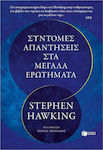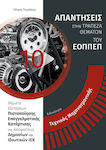Selected Store
Stock 20 pieces
Set the delivery location to see products according to your choice.

Selected Store
Stock 20 pieces

Scientific Books



Scientific Books




Scientific Books



Scientific Books

Prices are calculated for:Luxembourg, Other Payment Options
This book is primarily aimed at Civil Engineers and Builders who are involved in building and construction projects or in the quality control of building materials and constructions. It is a basic manual for students of polytechnic schools as it adequately covers the material that needs to be taught in the first semesters of the curriculum based on the course plan. The authors have taught the theoretical and experimental course on building materials in construction projects for many years. The first part of the book refers to the basic theoretical knowledge that an engineer should have regarding widely used conventional and new technology building materials. The second part provides an extensive reference to the materials used for the renovation and repair of buildings and/or constructions and describes the application of the main non-destructive methods used in the on-site quality control of building materials in building projects. It then describes the experimental methods for testing the properties of a newly built or under-repair technical project. This section is useful for the laboratory part of the course. CONTENTS Part A: Theory of Building Materials Chapter 1: Introductory Elements of Building Materials Questions – Exercises Bibliography Chapter 2: Natural Stones 2.1. Introduction 2.2. Types and kinds of rocks 2.3. Sedimentary Rocks 2.4. Igneous Rocks 2.5. CE marking on Natural Stone products 2.6. Properties of Natural Stones Questions Bibliography – References Chapter 3: Aggregates 3.1. Introduction – Geological categories of aggregates 3.2. Aggregates in construction projects 3.3. Sources of typical aggregates 3.4. Properties of aggregates Questions – Exercises Bibliography Chapter 4: Stone Building Materials – Bricks – Tiles – Ceramic Tiles 4.1. Introduction 4.2. Bricks 4.3. Tiles 4.4. Ceramic tiles Bibliography Chapter 5: Portland Cement 5.1. Introduction 5.2. Production of Portland cement 5.3. Chemical composition of Portland cement 5.4. Fineness of Portland cement 5.5. Specific gravity of Portland cement 5.6. Hydration of Portland cement 5.7. Structure of cement paste 5.8. Pores in hydrated cement 5.9. Properties of hydrated cement 5.10. Setting of Portland cement 5.11. Volume stability 5.12. Compressive strength of mortar 5.13. Water-Cement ratio 5.14. Types of Portland cements 5.15. Normal types of Portland cement 5.16. Other types of cements 5.17. Mixing water in Portland cement 5.18. Acceptable criteria 5.19. Applications 5.20. Concrete admixtures 5.21. Superplasticizers 5.22. Accelerators 5.23. By-products used in cementitious materials Questions Bibliography Chapter 6: Concrete 6.1. Introduction 6.2. Proportions in concrete mixing 6.3. Basic steps of weight and absolute volume methods 6.4. Concrete mix for small projects 6.5. Ready-Mix Concrete Production 6.6. Concrete placement 6.7. Concrete pumping 6.8. Vibration of concrete on site 6.9. Setting of concrete 6.10. Properties of hardened concrete Questions – Exercises Bibliography Chapter 7: Quality control of materials and constructions 7.1. Quality and quality control, a prerequisite for development 7.2.. Standardization – Certification – Accreditation 7.3. Quality assurance systems – ISO 9000 7.4. Control of technical studies and specifications of building constructions 7.5.
Quality Control of Public Works Bibliography Chapter 8: Steel 8.1. Introduction 8.2. Steel Production 8.3. Iron-Carbon Phase Diagram 8.4. Structural Steel 8.5. Reinforcement Steels 8.6. Steel Specimen Experiments 8.7. Torsion of Steel Specimens 8.8. Bending of Steel Beams 8.9. Hardness Determination 8.10. Ultrasound Application Questions – Exercises Bibliography – References Chapter 9: Masonry 9.1. Introduction 9.2. Masonry Units 9.3. Mortar 9.4. Grouts 9.5. Plaster Questions – Exercises Bibliography Chapter 10: Wood 10.1. Introduction 10.2. Structure of Wood 10.3. Anisotropic Structure of Wood 10.4. Chemical Composition of Wood 10.5. Moisture Content 10.6. Physical Properties 10.7. Mechanical Properties 10.8. Wood Products 10.9. Composite Structural Members 10.10. Eurocode 5 Design of Timber Structures 10.11. Computational Programs Questions – Exercises Bibliography Chapter 11: Composite Materials 11.1. Introduction 11.2. Properties of Composite Materials 11.3. Classification of Composite Materials 11.4. Applications of Composite Materials in Structural Works 11.5. Applications of FRPs in Construction Works Questions – Exercises Bibliography Part B: Experimental Methods for Assessing the Structural Integrity of Materials and Constructions Chapter 1 Materials for Restoration and Renovation of Buildings 1.1. Mortars 1.2. Plaster 1.3. Sealants and Insulating Materials Chapter 2 Methods for Assessing Structural Elements 2.1. Table of Methods for Checking Structural Elements 2.2. Methods for Checking Structural Elements Laboratory Exercises Introduction – General Instructions for Laboratory Exercises General Rules for Organization and Operation of Laboratories Laboratory Safety How to Write the Laboratory Report 1st Experiment: Measurement of Density of Building Materials 2nd Experiment: Measurement of pH of Various Building Materials with a Portable pH Meter 3rd Experiment: Shape and Surface Texture of Sand Grains 4th Experiment: Experimental Determination of Properties of Foamed Structural Polyurethane 5th Experiment: Determination of Concrete Strength with Ultrasound 6th Experiment: Determination of Concrete Strength Using the Oscillation Method 7th Experiment: Calculation of Thermal Conductivity Coefficient of Building Materials 8th Experiment: Determination of Expansion Coefficient of Structural Plaster 9th Experiment: Experimental Determination of Setting Point of Cement Mortar with VICAT Apparatus 10th Experiment: Experimental Determination of Concrete Strength with a Press 11th Experiment: Determination of Rock Hardness 12th Experiment: Determination of Moisture in Soils, Sand, and Fine Aggregates 13th Experiment: Measurement of Cement-Lime-Plastic Adhesion 14th Experiment: Study of Nail Penetration in Concrete with Windsor Hp Sensor System Appendices A: Statistical Analysis of Experimental Measurements and Graphical Representations B: Units and Unit Conversions of Physical Quantities C: Values of Thermal Conductivity Coefficient of Building and Insulating Materials Bibliography Index of TermsSpecifications are collected from official manufacturer websites. Please verify the specifications before proceeding with your final purchase. If you notice any problem you can report it here.